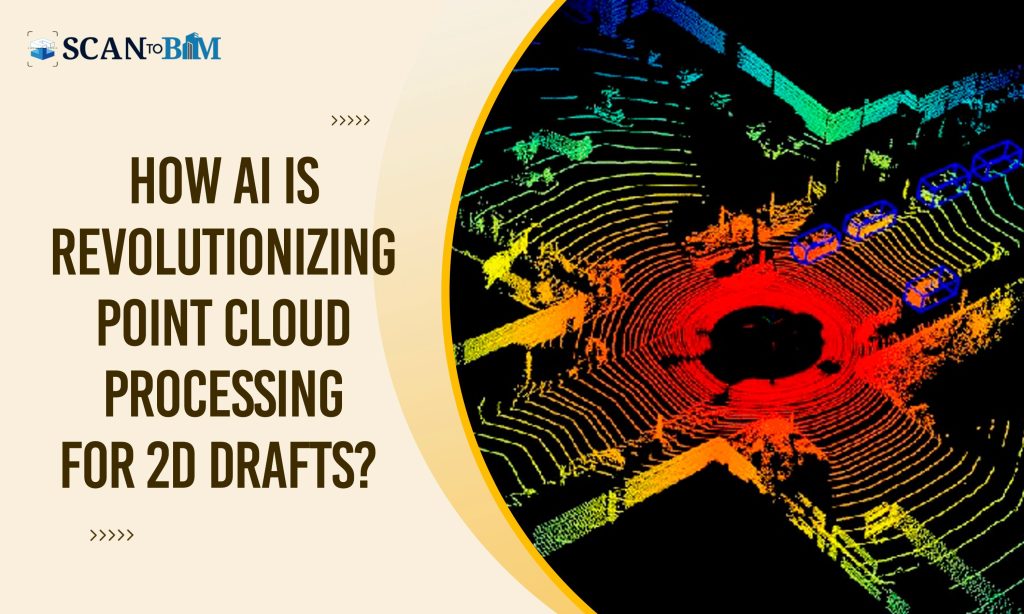
Introduction
Point cloud data captured using the LiDAR (Light Detection and Ranging) and the photogrammetry, has revolutionized the way we document and visualize the real-world structures. However, converting the massive point clouds into accurate 2D drafts remains a complex and time-consuming process. Artificial Intelligence (AI) is emerging as a powerful tool in automating and optimizing this conversion thereby offering an enhancement in speed, precision as well as the efficiency.
This blog explores how the AI-driven solutions can streamline the transformation of the point cloud data into the 2D drafts for various applications in the architecture, engineering and construction (AEC).
Challenges in Processing Point Clouds to 2D Drafts
- Data Complexity
The Point cloud datasets consist of millions to billions of the data points making the manual processing quite labour-intensive. Extracting the meaningful geometries along with the structural details from this data is a bit challenging task.
- Noise and Redundancy
The Point cloud scans often contains some redundant or noisy data due to the environmental factors, scanning errors or even due to the overlapping scans. The cleaning and filtering such data are very much crucial for producing the accurate 2D drafts.
- Manual Interpretation
Traditionally, the professionals used to rely totally on the manual tracing and interpretation of the point cloud data in just the CAD software. This method was quite prone to the human errors and used to lead to inconsistencies in the final drafts.
- Time and Cost Constraints
Manually processing of the point clouds into the 2D drawings requires a force of skilled labours along with the significant time thereby leading to increased in the project costs and potential delays.
How AI Enhances Point Cloud to 2D Draft Conversion?
- Automated Feature Extraction
AI algorithms can analyse the point clouds and identify the key architectural or structural elements such as walls, doors, windows and columns. The Machine learning models trained on the larger datasets can recognize the patterns and automatically segment these features hence reducing the manual efforts to a greater extent.
- Noise Reduction and Data Refinement
AI-powered filtering techniques can remove the outliers and also the redundant data points more efficiently than any traditional methods. By applying the deep learning models, AI can distinguish between the relevant structural details as well as the noise ultimately ensuring a cleaner dataset for the draftings.
- Intelligent Linework Generation
The Deep learning models such as the convolutional neural networks (CNNs) can convert the point clouds into the vectorized linework thereby producing the accurate 2D representations of the buildings and the infrastructures. These models can predict the edges, contours along with the structural elements with high precision, mimicking the way any human drafters would interpret the data.
- AI-Assisted CAD Workflows
The AI-integrated CAD software can process the point clouds and generate the initial 2D drafts that any professionals can refine further. This hybrid approach along with the accurate Scan to CAD Services significantly speeds up the workflows thereby allowing the engineers and the architects to focus on their core designs rather than the tedious drafting tasks.
- Improved Accuracy and Consistency
AI reduces the human errors by ensuring the consistent linework and precise measurements in the 2D drafts. The Machine learning algorithms continuously improves through the training thereby enhancing their ability to interpret any complex structures more accurately over the period of time.
Applications in the AEC Industry
- Architectural Documentation
AI-driven point cloud processing enables the architects to quickly generate the 2D floor plans and elevation drawings from the scanned data ultimately streamlining the renovations and restoration projects.
- Structural Engineering Analysis
The Engineers can extract any critical structural details from the point clouds with the help pf the AI assistance thereby facilitating the accurate load calculations as well as the design assessments.
- Heritage Preservation
AI helps to convert the historical site scans into precise 2D drawings hence preserving the architectural details with the minimal manual interventions.
- Facility Management and Retrofitting
AI-generated 2D drafts from the point clouds assists the facility managers in updating the as-built documentations for the future maintenances and renovation plannings.
Conclusion
Artificial Intelligence is transforming the way any point cloud data is processed into the 2D drafts, significantly reducing the time, cost and also the errors associated with the traditional methods. By automating the feature extraction, noise reduction and linework generations, the AI-powered solutions are enhancing the efficiency in the AEC industry.
As AI technology continues to evolve, its role in the point cloud processing will only become more sophisticated thereby making it an indispensable tool for the architects, engineers as well as the designers.
By embracing these AI-driven solutions, the Scan to BIM Company will not only improve the productivity but also ensure higher-level of accuracy and consistency in the 2D drafting workflows thereby paving the way for the smarter and more efficient design processes.